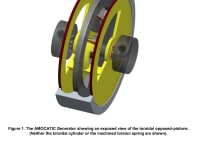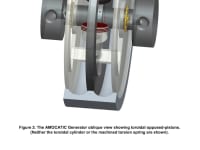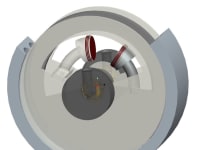
The proposed combustion generator is designed to produce electrical power in the range 1 kW – 150 kW. It potentially does this with high efficiency, excellent power-weight-ratio, greater compactness, and low noise and vibration characteristics, making it suitable as a range extender for electric vehicles (EVs), or as a generator in the domestic Combined Heat and Power (CHP) market. Existing low power generators suffer from low efficiencies, high levels of noise and vibration, and when not in use, they cannot be used to store kinetic energy as a flywheel. Conventional combustion engine generator sets (with slider-crank mechanisms) always have some dynamic unbalance, making them noisy. This proposed rotary semi-free opposed-toroidal-piston design has only two moving parts achieving total dynamic balance with just one cylinder.
This patented design is an improvement on what is currently in the market place because it incorporates all the thermal efficiency, low friction, and low noise and vibration benefits of a free piston engine but overcomes the associated control and stability issues. Moreover it exploits resonance, avoiding high electrical machine forces, massively reducing resistive and eddy current losses, thereby significantly increasing electrical machine efficiency.
The market prospects for the proposed design are very good, both as an EV range extender, and as a generator in the domestic CHP market. Global road transport faces the challenge over the next 25 years of how it can get create clean, efficient, and affordable vehicle powertrains. The domestic micro-CHP sector by contrast faces the challenge of how it will source efficient low-power generators with very low noise emissions. Existing small generators have nowhere near acceptable efficiency. On the transport front, there are only two volume-produced vehicles on the market fitted with a range extender. Auto Express magazine ranked one of these - the BMW i3 - as the best hybrid car on sale in 2016. Nissan (which has the best-selling all-electric vehicle) is planning a range-extended EV with a petrol engine range extender. For range extenders to have environmental impact they need to be very efficient at sufficient power i.e. around 100 kW. Similarly, for CHP systems a 1kW Stirling cycle free-piston generator is on the market but its thermal efficiency of 23% needs to be improved. The proposed design meets these challenges.
So how does it work? Essentially use of toroidal pistons and a matching toroidal cylinder enables mass unbalance and side-thrust to be totally eliminated, reducing friction from the ring pack. Also, because the pistons are connected by a stiff alloy spring it enables timed combustion to exploit resonance. Resonance allows much lower electrical-machine forces causing lower electrical power losses.
The toroidal pistons and a matching toroidal cylinder could be manufactured by casting, with some finishing by 5-axis milling machine. The torsion spring could be machined directly from tube. Rapid prototyping could be achieved through laser sintering. Production costs would initially be higher than generator products already on the market, whose manufacturing processes have been perfected over 50 years. Manufacturing costs would however come down with volume production.
-
Awards
-
 2016 Top 100 Entries
2016 Top 100 Entries
Like this entry?
-
About the Entrant
- Name:Julian Dunne
- Type of entry:individual
- Software used for this entry:MATLAB; ANSYS
- Patent status:patented








